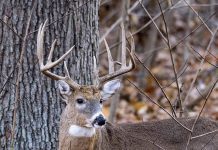“Proper heifer development is key to a successful cattle herd and profitable operation,” says Patrick Davis MU Extension Livestock Field Specialist. As herds rebuild from drought or old cow turnover due to favorable prices, heifer development is taking place to build the next cowherd. Also, as cattle producers look to buy replacement heifers, this can be a way to add value to your cattle operation. Therefore, Davis will provide some management strategies to consider in heifer development to produce a female that will be successful to you and your customer’s operation.
“Nutritional management is important to heifer development,” says Davis. Manage heifers to 55% to 65% of their mature body weight prior to the breeding season. This range depends on animal type and environment. Body Condition Score (BCS), which evaluates animal condition or fat cover on a 1 to 9 scale, is linked to heifer energy status and reproductive performance. Manage heifer BCS at a 5 to 6 prior to the breeding season to achieve optimum pregnancy rates. Refer to MU Extension Guide G2028 and MU Extension Guide G2230 for more information.
“The prebreeding exam is important to heifer development,” says Davis. This exam is done by a veterinarian through rectal palpation 30 to 60 day prior to the breeding season to help determine if the heifers are reproductively sound to become pregnant during the breeding season. The prebreeding exam includes measuring the pelvic area (PA) and evaluating the reproductive tract (RT). The (RT) is scored (RTS) on a 1 to 5 scale with 1 being infantile and 4 and 5 being mature enough to become pregnant. For optimum heifer pregnancy rates, heifers should have a RTS of 3 or greater. PA (pelvic width X height) measurement determines if the heifer’s pelvis is large enough to pass a calf with ease. Based on Missouri Show Me SelectTM (SMS) Replacement Heifer Program Requirements, heifers need to measure a PA of at least 150 cm2 at prebreeding. Heifers with smaller PA can be remeasured at pregnancy check within 90 days of the start of the breeding season but must measure 180 cm2 at this time. If heifers fail both measurements, they should be culled. Davis suggests utilizing this protocol along with breeding heifers to a calving ease sire to reduce calving difficulty issues. Refer to MU Extension Guide G2028 for more information.
“Use genomic testing to retain heifers with optimum genetics for you and your customer’s operation,” says Davis. Furthermore, if you are planning to sell these replacement heifers, this information helps in marketing and may lead to premiums. Davis suggests using the proper test based on the heifer breed and desired information. Look at MU Extension Guide G2094 for more information.
Davis suggests using artificial insemination (AI) to breed replacement heifers because of the many benefits to you and your customer’s operation which are mentioned below:
- AI bred heifers typically sell at a higher value compared to natural services (NS) bred heifers. This is probably due to confidence in genetic quality of the calf and calving date.
- AI bred heifers will calve earlier in the calving season which means calves should be older and heavier at weaning compared to their NS counterparts.
- AI born calves have better genetic quality than NS calves. When selecting AI bulls, it is important to use sires that are high accuracy for the traits that are important to you and your customer’s operation. This increases the likelihood that AI sired calves will perform better than NS sired calves in these operations.
“Use an estrous synchronization protocol and have a good plan in place if you plan to utilize AI,” says Davis. For more information refer to MU Extension Guide G2025.
“Heifer breeding season should be relatively short,” says Davis. Use a 60 day or less breeding season and cull any open heifers following the breeding season. This promotes retaining highly fertile heifers since they are more likely to conceive and become pregnant in the short breeding window. This also increases heifer likelihood of rebreeding and being retained in the herd after their first calf is weaned. Calves of these heifers will be born earlier in the calving season which increases their chances of being older and heavier at weaning.
“Pregnancy check and cull open heifers at approximately 90 days after the beginning of the breeding season,” says Davis. This allows for fetal sexing the calf and a more accurate calving date to be determined for you and your customer’s operation. The quicker these open heifers are identified and sold, the more valuable they are to the feedyard. Also, operation profitability is improved by not wasting feed resources on open heifers.
“Work with your veterinarian to develop a proper vaccination and parasite control program to help heifers develop to their full potential,” says Davis. MU Extension Guide G2044 provides a vaccination and parasite control framework to help guide your herd’s health program.
“These strategies mentioned above have helped the SMS Replacement Heifer Program be successful and provide a reliable source of replacement heifers for over 25 years,” says Davis. Furthermore, it helps Missouri cattle operations add value through the sale of bred replacement heifers. For more information on heifer development, the SMS Replacement Heifer Program, how to enroll heifers in the program, and program sales contact your local MU Extension Livestock Field Specialist or visit the program website at https://extension.missouri.edu/programs/show-me-select-replacement-heifer-program.


















